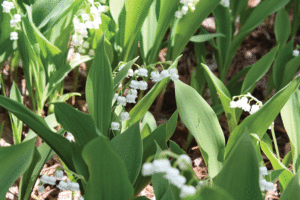
Convallaria majalis “Albostriata” that has dark green leaves with white stripes. (Photo by Ginny Rosenkranz)
One of the most wonderful surprises of spring is the emergence of some herbaceous perennials that have been dormant all winter long.
As the soil warms up the plants begin to push their foliage out into the warm spring air.
Some need all summer before the flowers emerge, but some very lovely ones bloom almost as soon as the foliage emerges.
The Lily of the Valley is one of those springtime treasures that blooms in May with an arching stem of tiny pure white, very fragrant bell shaped flowers.
The stems can grow 4-9 inches long which hold five to 10 sweetly scented flowers that are only a third of an inch long.
The fragrance of the flowers perfumes the air for at least two to three weeks, and the flowers can be cut and brought indoors for tiny bouquets.
Lily of the Valley grows best in moist partly or lightly shady gardens and the dark green pairs of leaves make a lovely summer groundcover that colors the gardens from spring to late fall. The-lance shaped leaves can grow 8-15 inches tall.
The plants grow by underground rhizomes, which are often called “pips,” and can be dug and divided for sharing in late fall.
A few plants can become a dense groundcover in a few short years.
There are some lovely cultivars such as Convallaria majalis “Albostriata” that has dark green leaves with white stripes down the length of each leaf and “Aureomarginata” that has dark green leaves with cream colored margins.
Both of these cultivars add a brighter note in the shady garden after the waxy white flowers fall off the slender stems.
Another cultivar, “Fortin’s Giant” has both larger pairs of leaves and larger fragrant flowers, while “Flore Plena” has double flowers on each stem.
There is also a pink cultivar, “Rosea” that is not as vigorous as the white flowering Lily of the Valley but lovely in its own right.
The plants are poisonous so rabbits and deer do not feast on the Lily of the Valley.
(Editor’s Note: Ginny Rosenkranz is a commercial horticulture specialist with the University of Maryland Extension.)



